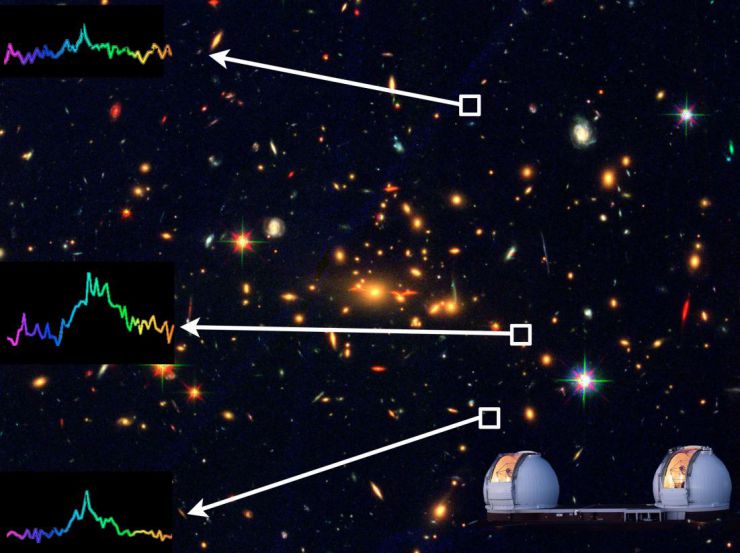Astronomers See Faintest, Furthest Galaxy
By Andy Fell on May 19, 2016 in Science & Technology

Quick Summary
- Image of faint galaxy magnified by gravitational lens
- Object seen as it was 13 billion years ago
- Clues to understanding “reionization epoch†of our universe
A team of scientists led by two UC Davis physicists has detected and confirmed the faintest early-universe galaxy yet. This new object, seen as it was about 13 billion years ago, could help astronomers understand the “reionization epoch†when the first stars became visible.
Gravitational lensing and a special instrument on the 10-meter telescope at the W.M. Keck Observatory on the summit of Mauna Kea, Hawaii, enabled the team to see the incredibly faint object. The findings are published in Astrophysical Journal Letters today, May 19.
Gravitational lensing is a phenomenon predicted by Einstein. Because gravity can bend the path of light, it’s possible for a distant galaxy to be magnified through the “lens†created by the gravity of another object between it and the viewer. In this case, the detected galaxy was behind the galaxy cluster MACS2129.4-0741, which is massive enough to create three different images of the object. The astronomers were able to show that the three images were of the same galaxy because they showed similar spectra.
It would not have been visible at all if the light from the galaxy was not magnified by the gravitational lens, said UC Davis postdoctoral researcher Kuang-Han Huang, lead author of the paper.
Understanding the early universe
At 13 billion years old, the galaxy lies near the end of the reionization epoch, during which most of the hydrogen gas between galaxies transitioned from being mostly neutral to being mostly ionized, and the stars appeared for the first time. The discovery shows how gravitational lensing can help us understand the faint galaxies that dominate this important period of the early universe, Huang said.
“This galaxy is exciting because the team infers a very low stellar mass, or only 1 percent of 1 percent of the Milky Way galaxy,†said Marc Kassis, staff astronomer at the Keck Observatory. “It’s a very, very small galaxy and at such a great distance, it’s a clue in answering one of the fundamental questions astronomy is trying to understand: What is causing the hydrogen gas at the very beginning of the universe to go from neutral to ionized about 13 billion years ago? That’s when stars turned on and matter became more complex.â€
“To see where no human has seen beforeâ€
“Keck Observatory’s telescopes are simply the best in the world for this work,†said UC Davis physics professor and co-team leader Marusa Bradac. “Their power, paired with the gravitational force of a massive cluster of galaxies, allows us to truly see where no human has seen before.â€
The galaxy’s magnified images were originally seen separately in both Keck Observatory and Hubble Space Telescope data. The team used the DEIMOS (DEep Imaging and Multi-Object Spectrograph) instrument on the 10-meter Keck II telescope to confirm that the three images were of the same object.
The core of the team consisted of Bradac, Huang, Brian Lemaux and Austin Hoag of UC Davis. Keck Observatory astronomers Luca Rizzi and Carlos Alvarez were instrumental in helping the team collect the DEIMOS data. Tommaso Treu from UCLA and Kasper Schmidt of Leibniz Institute for Astrophysics, Potsdam, were also part of the team.
Keck Observatory is a private 501(c) 3 nonprofit organization and a scientific partnership of the California Institute of Technology, the University of California and NASA.
Media contact(s)
Marusa Bradac, Physics, 530-752-6762 , marusa@physics.ucdavis.edu
Andy Fell, News and Media Relations, 530-752-4533, ahfell@ucdavis.edu
Media Resources
Tags
AstronomyCategories
Science & TechnologyPublished: May 23, 2016, 3:35 pm

